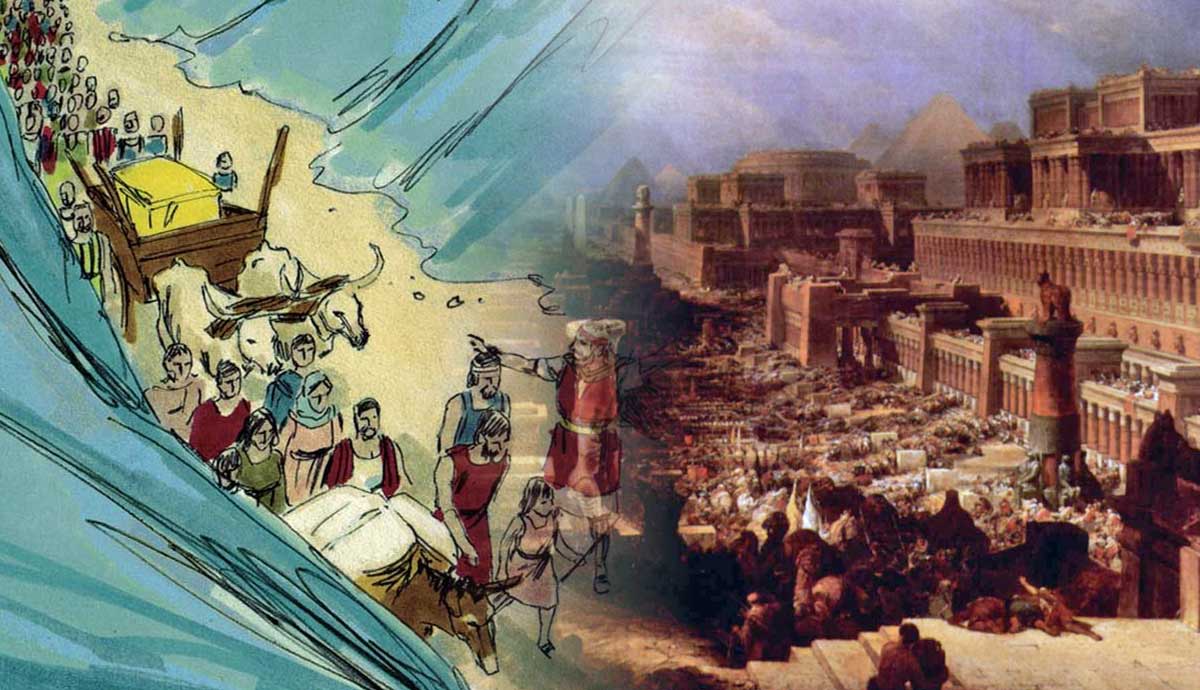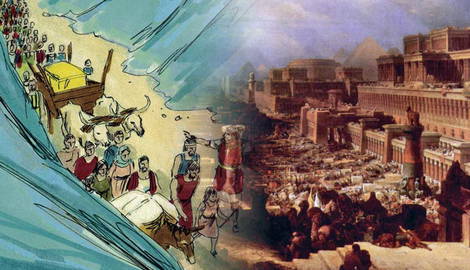
The Israelites’ exit from Egypt is one of the most iconic occurrences in Judaism and it remained significant in the later Christian tradition. Even though there are many challenges to the historicity of the biblical account, images of Moses dividing the Red Sea endure, in pictures and movies that portray the scene. No Egyptian record of such an event exists. Is there evidence of a mass exodus of Israelites from Egypt as described in the Bible? Can historians reliably determine how the Israelites escaped from Egypt?
The Biblical Narrative

According to the Biblical narrative, Moses met with the Egyptian Pharaoh, accompanied by Aaron, to request that he set the Israelites free. After each refusal, God struck Egypt with a plague that would cause Pharaoh to promise the Israelites’ release. After the tenth plague, during which the eldest sons of those who did not put the blood of a lamb on their doorposts and lintels died, Pharaoh agreed to let the Israelites go. Shortly after letting the Israelites go, Pharaoh sent his armies after them. The Israelites found themselves trapped between the armies of Pharaoh and the Red Sea.
By divine intervention the Red Sea parted, and the Israelites could cross to the other side on dry ground. Exodus 14:21 reads: “Then Moses stretched out his hand over the sea, and the LORD drove the sea back by a strong east wind all night and made the sea dry land, and the waters were divided.” The biblical account refers to “the waters being a wall to them on their right hand and on their left” (v 22).

The Egyptian armies, in hot pursuit and being on chariots, would easily be able to catch up with the Israelites. They entered between the walls of water where the Israelites had gone through shortly before. However, the wheels of their chariots clogged up, causing difficulty. This obstacle threw the Egyptian armies into a panic. They perceived the divine intervention at work and attempted to flee from their predicament by returning to the shore on the Egyptian side.
On the command of God, Moses again stretched out his hand, and the waters of the Red Sea suddenly returned, engulfing the Egyptian armies. The Egyptian army was destroyed, including Pharaoh. The Israelites were now free from their enslavers and could traverse the desert to the promised land.
The whole ordeal is said to have occurred at night. The wind blew all night, and the Egyptian armies entered between the walls of water during the morning watch, which is the last of the night watches that lasted until dawn.
Theories on the Exodus

The Bible narrative does not provide critical details about the period and location of the exodus. It does not identify which Pharaoh reigned at that time, but scholars believe it was most likely Ramses II.
The absence of any reference to the exodus in Egyptian records is not surprising. The Egyptians, like many other nations, would omit embarrassing losses and failures from their records. The loss of a whole nation of slaves would be a blemish on the name of a Pharaoh who was otherwise known for the magnificent architectural feats performed during his reign. The construction of these buildings was supposedly done by the jews themselves.
As far as the location of the crossing goes, the passage of time and the change of typography due to factors like siltation and marsh growth could have changed the shoreline and buried any evidence of a crossing. Still, various scholars propose different possible crossing sites that range from a bay near the Mediterranean to southern Aqaba at the Straits of Tiran. The possible crossing points can be divided into four categories.
A Northern Coastal Route

Some scholars have considered the translation of the Hebrew term “Yam Suph” as Red Sea, dubious. The term actually translates to Reed Sea. If correct, a shallow marshy area lined by reeds not too far from the Mediterranean is a possible location for the crossing. Even then, the exact location of such a Reed Sea is unclear. Continuous wind could, however, expose shallow areas in such a lake and would dry it out.
Even without an exact location for such a reed sea, the hypothesis faces significant challenges from the Biblical narrative. Though a shallow Reed Sea may account for the Israelites being able to cross it, reconciling such a place with walls of water is difficult. It would also be a miracle if the entire Egyptian Army on chariots drowned in a shallow marsh that the Israelites crossed on foot that same evening.
In addition, Exodus 13:17 says: “God did not lead them by way of the land of the Philistines, although that was near.” Seeing as they left Goshen in northern Egypt, their route seems to have taken them southeast to avoid the Philistines on their way to the promised land. A Northern route is, therefore, unlikely.
The Bitter Lakes

North of the Suez lies an area known for its shallow, salty lakes. Some have run dry after the construction of the Suez Canal, but these lakes may have been deep enough for Charioteers to drown in.
It is impossible to know exactly how large these lakes would have been thousands of years ago. For the Israelites to have camped by the “Reed Sea” for four days after crossing it, such a lake must have been a significant size. It is conceivable that such a lake could have made walls of water when deep enough and divided. This option leaves many possible crossing points that may be miles away from any body of water around today.
The Suez

It would have been possible for the Israelites to reach the Gulf of Suez in the days after Pharaoh let them go. Today, the Gulf of Suez has a shallow stretch that crosses the gulf with a depth of only ten meters (32 feet). It may have been even less thousands of years ago. If the armies of Ramses approached the Israelites from the west at Adabiya, they would have been trapped between the sea to their north and east and the mountains to the south.
Today, they would still be in Egypt once they crossed, but the Sinai Peninsula constituted foreign land during Ramses II’s reign. The crossing would have taken some hours by foot. The land bridge of dried seabed, if Adabiya is the correct location and its current width was the same, is approximately nine kilometers (5.5 miles).
The Gulf of Aqaba

The Gulf of Aqaba itself offers several possible crossing points. Just north of the gulf, a couple of lakes may have been the scene of a crossing. Several names associated with the area match places the Israelites visited during their journey.
The Nuweiba in mid-Aqaba is a possibility. Ron Wyatt has made many claims that this is the crossing point. Many of his claims have been proven false, and he has no archaeological proof to support others. Nonetheless, pictures of the supposed chariot wheels discovered underwater have gained notoriety on the internet and on social media networks. With a minimum depth of 800m (2624 feet), a crossing here would require a steep descent and ascent on the other side. Considering the number of Israelites, such a feat would be highly unlikely due to some elderly and children in their ranks.
The Strait of Tiran in the South of Aqaba would be the narrowest point for a crossing. This crossing point, the farthest suggested, is unlikely for the time frame involved. The terrain in the sea here would make crossing it impossible today due to the coral reefs. However, it may have looked very different back in Moses’ day.
Conclusion

The Bible narrative on the crossing of the Red/Reed Sea does not provide enough information to determine precisely where it occurred. There are several possibilities but no evidence to support any of the theories. Unfortunately, some of the most popular theories proposed on the internet and social media have no reliable archaeological evidence to support them. There is insufficient evidence to determine where these events may have occurred.










